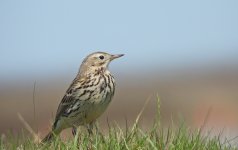UKBirder23
Well-known member
Hello everyone,
Tricky question today, as it concerns pipits and I have no photos! So I was at Breydon Water in Norfolk yesterday afternoon with fellow birders (my mum and sister, to be precise), and saw two pipits, although one of them disappeared quite early in the proceedings. I've never seen any sort of pipit before, and my initital thought was that it was rather similar to a Dunnock, only bigger. Something in the nature of a skylark as well but obviously not one. Seeing it from the back, which was a fairly uniform medium brown colour with streaks running down the mantle, I then thought of warblers. It had two white wing bars and white on the outsides of the tail. By this point I had realised it was a pipit, but what pipit? Its character was very shy. It wouldn't let us get closer than about twenty feet, if that, and then it would fly off with its bouncing flight, quite low, and land about sixty feet away. Sadly I could not get a good look at the leg colour - the light was poor and it was always standing in the mud on the very edge of the shoreline. I assume the legs were brown or greyish- if they had been light or coloured I think I would have been able to see them. When sitting, it did not move its tail that I noticed. The main one that we watched did not seem to have a white eye stripe, although it did have a light eye ring. The first one I saw, which then disappeared, gave the impression of a brown patch on its cheek, which tells me that it did have a white eye stripe. I did get one look from the front, and thought that it had very striking brown stripes down the front. Nowhere else on the bird was its marking so striking, apart from the thin wing bars.
So... Meadow, Rock or Water? We think it was too big, and overall not strikingly marked enough, and too light of brown, and perhaps not in the most likely location, to be a Meadow Pipit. My mum and sister are convinced it was a Water Pipit. They are better at ID'ing birds than I am, but I'm sceptical because Water Pipits are the rarest of the three. Still, Breydon Water has always been kind to us, last time we were there for about ten minutes and saw a Bittern and a Spoonbill.
Any thoughts at all? Or perhaps, did any more experienced birder see any pipits at Breydon Water yesterday?
Thank you in advance for any help, and sorry for asking such a tricky question!
Tricky question today, as it concerns pipits and I have no photos! So I was at Breydon Water in Norfolk yesterday afternoon with fellow birders (my mum and sister, to be precise), and saw two pipits, although one of them disappeared quite early in the proceedings. I've never seen any sort of pipit before, and my initital thought was that it was rather similar to a Dunnock, only bigger. Something in the nature of a skylark as well but obviously not one. Seeing it from the back, which was a fairly uniform medium brown colour with streaks running down the mantle, I then thought of warblers. It had two white wing bars and white on the outsides of the tail. By this point I had realised it was a pipit, but what pipit? Its character was very shy. It wouldn't let us get closer than about twenty feet, if that, and then it would fly off with its bouncing flight, quite low, and land about sixty feet away. Sadly I could not get a good look at the leg colour - the light was poor and it was always standing in the mud on the very edge of the shoreline. I assume the legs were brown or greyish- if they had been light or coloured I think I would have been able to see them. When sitting, it did not move its tail that I noticed. The main one that we watched did not seem to have a white eye stripe, although it did have a light eye ring. The first one I saw, which then disappeared, gave the impression of a brown patch on its cheek, which tells me that it did have a white eye stripe. I did get one look from the front, and thought that it had very striking brown stripes down the front. Nowhere else on the bird was its marking so striking, apart from the thin wing bars.
So... Meadow, Rock or Water? We think it was too big, and overall not strikingly marked enough, and too light of brown, and perhaps not in the most likely location, to be a Meadow Pipit. My mum and sister are convinced it was a Water Pipit. They are better at ID'ing birds than I am, but I'm sceptical because Water Pipits are the rarest of the three. Still, Breydon Water has always been kind to us, last time we were there for about ten minutes and saw a Bittern and a Spoonbill.
Any thoughts at all? Or perhaps, did any more experienced birder see any pipits at Breydon Water yesterday?
Thank you in advance for any help, and sorry for asking such a tricky question!
Last edited:





